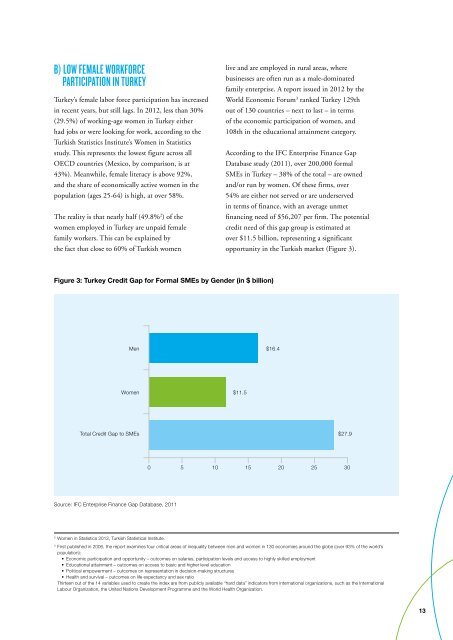ENTREPRENEURS IN TURKEY
GTsvO3
GTsvO3
You also want an ePaper? Increase the reach of your titles
YUMPU automatically turns print PDFs into web optimized ePapers that Google loves.
B) LOW FEMALE WORKFORCE<br />
PARTICIPATION <strong>IN</strong> <strong>TURKEY</strong><br />
Turkey’s female labor force participation has increased<br />
in recent years, but still lags. In 2012, less than 30%<br />
(29.5%) of working-age women in Turkey either<br />
had jobs or were looking for work, according to the<br />
Turkish Statistics Institute’s Women in Statistics<br />
study. This represents the lowest figure across all<br />
OECD countries (Mexico, by comparison, is at<br />
43%). Meanwhile, female literacy is above 92%,<br />
and the share of economically active women in the<br />
population (ages 25-64) is high, at over 58%.<br />
The reality is that nearly half (49.8% 2 ) of the<br />
women employed in Turkey are unpaid female<br />
family workers. This can be explained by<br />
the fact that close to 60% of Turkish women<br />
live and are employed in rural areas, where<br />
businesses are often run as a male-dominated<br />
family enterprise. A report issued in 2012 by the<br />
World Economic Forum 3 ranked Turkey 129th<br />
out of 130 countries – next to last – in terms<br />
of the economic participation of women, and<br />
108th in the educational attainment category.<br />
According to the IFC Enterprise Finance Gap<br />
Database study (2011), over 200,000 formal<br />
SMEs in Turkey – 38% of the total – are owned<br />
and/or run by women. Of these firms, over<br />
54% are either not served or are underserved<br />
in terms of finance, with an average unmet<br />
financing need of $56,207 per firm. The potential<br />
credit need of this gap group is estimated at<br />
over $11.5 billion, representing a significant<br />
opportunity in the Turkish market (Figure 3).<br />
Figure 3: Turkey Credit Gap for Formal SMEs by Gender (in $ billion)<br />
Men $16.4<br />
Women $11.5<br />
Total Credit Gap to SMEs $27.9<br />
0 5 10 15 20 25 30<br />
Source: IFC Enterprise Finance Gap Database, 2011<br />
2<br />
Women in Statistics 2012, Turkish Statistical Institute.<br />
3<br />
First published in 2006, the report examines four critical areas of inequality between men and women in 130 economies around the globe (over 93% of the world’s<br />
population):<br />
• Economic participation and opportunity – outcomes on salaries, participation levels and access to highly skilled employment<br />
• Educational attainment – outcomes on access to basic and higher level education<br />
• Political empowerment – outcomes on representation in decision-making structures<br />
• Health and survival – outcomes on life expectancy and sex ratio<br />
Thirteen out of the 14 variables used to create the index are from publicly available “hard data” indicators from international organizations, such as the International<br />
Labour Organization, the United Nations Development Programme and the World Health Organization.<br />
13


